Understanding your 2013 Hyundai Elantra’s fuse box is crucial for maintaining its electrical system. If you’re experiencing issues with your car’s accessories or systems, checking the fuses should be one of your first steps. This guide will specifically focus on the 2013 Hyundai Elantra Obd2 Fuse Location and provide a detailed overview of all fuse box locations, helping you diagnose and resolve electrical problems efficiently.
Locating the Fuse Boxes in Your 2013 Hyundai Elantra
For the 2013 Hyundai Elantra, you’ll find the primary fuses in two main locations: the interior fuse box, situated under the dashboard, and the engine compartment fuse box. Knowing both locations is essential for a complete understanding of your vehicle’s fuse system.
Interior Fuse Box Location (Under the Dashboard)
The interior fuse box in your 2013 Hyundai Elantra is conveniently located beneath the driver’s side dashboard. This location is easily accessible and houses fuses that control many of the car’s interior electrical components, including lights, power outlets, and certain electronic modules.
To access this fuse box:
- Locate the panel beneath the steering wheel, on the driver’s side.
- You may need to kneel down and look upwards to see it clearly.
- The fuse box cover usually has a diagram on it, or it may be a simple plastic cover that you can pull off.
Once you’ve located and opened the interior fuse box, you’ll see an arrangement of fuses and relays. Refer to the fuse diagram (often found on the inside of the fuse box cover or in your owner’s manual) to identify the specific fuse you need to check related to your issue, including potential fuses related to the OBD2 system.
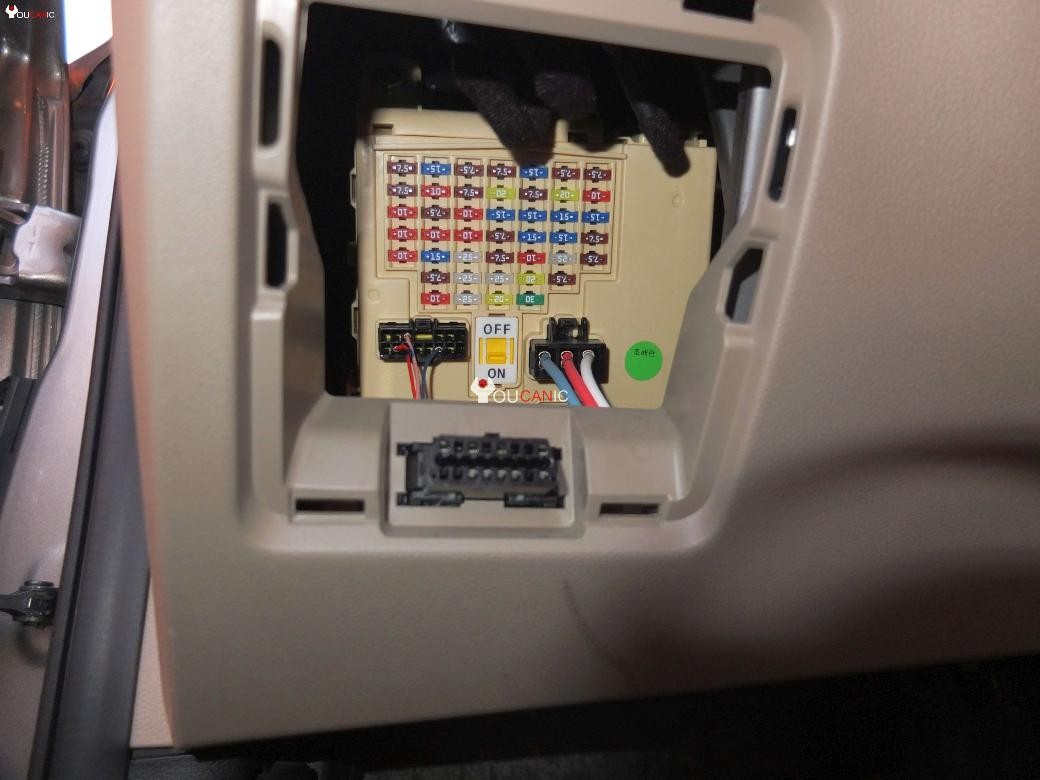 Interior fuse box diagram for Hyundai Elantra, highlighting fuse locations and descriptions.
Interior fuse box diagram for Hyundai Elantra, highlighting fuse locations and descriptions.
Here is a detailed list of the fuses within the interior instrument panel fuse box for the 2013 Hyundai Elantra:
| Fuse Name | Fuse rating | Protected Component |
|---|---|---|
| START | 7.5A | W/O Smart Key: ICM Relay Box(Burglar Alarm Relay), With Smart Key: A/T – Transaxle Range Switch, M/T – ECM, E/R Fuse & Relay Box(Start 1 Relay), Smart Key Control Module |
| A/BAG | 15A | SRS Control Module, Passenger Weight Classification Sensor |
| A/BAG IND | 7.5A | Instrument Cluster |
| CLUSTER | 7.5A | ISG LDC (Audio), Cluster (ISG) |
| C/LIGHTER | 15A | Cigarette Lighter |
| BCM | 7.5A | Smart Key Control Module, BCM |
| A/CON SWITCH | 7.5A | A/C Control Module |
| MODULE 2 | 7.5A | Electro Chromic Mirror, ESC Off Switch |
| MDPS | 10A | EPS Control Module |
| MODULE 4 | 7.5A | Rear Parking Assist Sensor LH/RH (IN/OUT), A/C Control Module(Auto A/C), ATM Lever Indicator |
| IG1 | 20A | E/R Fuse & Relay Box(Fuse – TCU 1, B/UP LP, ECU 3, ABS 3) |
| PDM 3 | 7.5A | Smart Key Control Module |
| POWER OUTLET FRT | 20A | Power Outlet |
| MODULE 6 | 10A | AMP, Power Outside Mirror Switch, Audio, A/V & Navigation Head Unit, Digital Clock |
| HTD MIRR | 10A | Driver/Passenger Power Outside Mirror, A/C Control Module |
| MODULE 3 | 7.5A | Audio, Tire Pressure Monitoring Module, Digital Clock, BCM, Instrument Cluster, Driver/Passenger Seat Warmer Module |
| BRAKE SWITCH | 10A | – |
| SPARE | 15A | – |
| SUNROOF | 15A | Sunroof |
| SPARE | 15A | – |
| SPARE | 15A | – |
| BLOWER | 10A | Manual A/C – A/C Control Module, ECM/PCM, Blower Resistor |
| INTERIOR LAMP | 10A | Luggage Lamp, Vanity Lamp LH/RH, Room Lamp, Overhead Console Lamp, Ignition Key Ill. & Door Warning Switch(W/O Smart Key) |
| TRUNK | 10A | Trunk Relay |
| MODULE 1 | 7.5A | Sport Mode Switch(A/T), Key Solenoid(W/O Smart Key) |
| SPARE | 15A | – |
| S/HEATER RR | 15A | Rear Seat Warmer Switch LH/RH |
| MODULE 7 | 7.5A | Smart Key Control Module, BCM |
| MULTIMEDIA | 15A | Audio, A/V & Navigation Head Unit |
Engine Compartment Fuse Box Location
The second fuse box in your 2013 Hyundai Elantra is located in the engine compartment. This fuse box typically houses fuses and relays that protect more critical vehicle systems, such as the engine control unit (ECU), anti-lock braking system (ABS), and cooling fan.
To find the engine compartment fuse box:
- Open the hood of your Hyundai Elantra.
- Locate a black plastic box, usually near the battery or engine bay side panel.
- It will have a cover that is typically secured by clips or tabs.
After opening the engine compartment fuse box, you’ll find another set of fuses and relays. Again, consult the fuse diagram to locate the specific fuse you need to inspect. This fuse box is less likely to contain a fuse directly labeled “OBD2,” but it houses fuses for systems that are crucial for OBD2 diagnostics to function, such as the ECU/PCM.
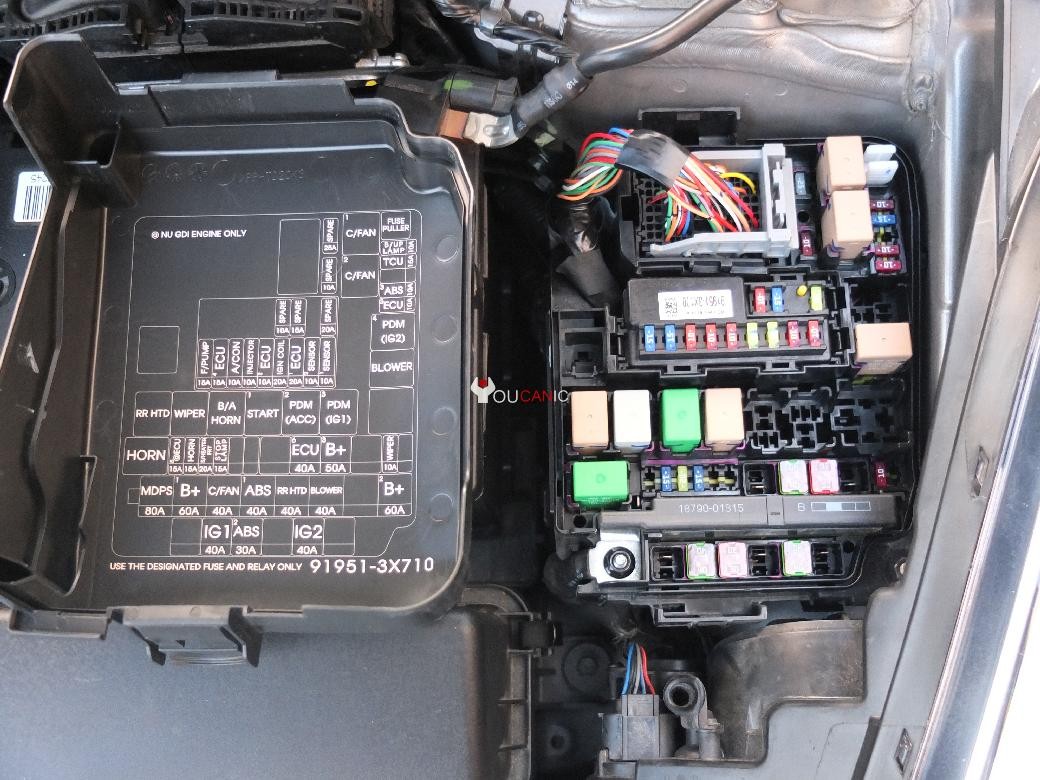 Diagram showing the location of the fuse box in the engine compartment of a Hyundai Elantra.
Diagram showing the location of the fuse box in the engine compartment of a Hyundai Elantra.
Below is the fuse list for the engine compartment fuse panel of your 2013 Hyundai Elantra:
| MDPS | 80A | EPS Control Module | |
|---|---|---|---|
| B+1 | 60A | SmartJunction Box(ARISU 1 (4CH), IPS 1, FUSE – P/WDW LH, P/WDW RH, TRUNK, AMP 1) | |
| C/FAN | 40A | C/FAN Lo Relay, C/FAN Hi Relay | |
| ABS 1 | 40A | ESC Module, Multipurpose Check Connector | |
| RR HTD | 40A | RR HTD Relay | |
| BLOWER | 40A | Blower Relay | |
| SPARE | 40A | – | |
| B+2 | 60A | Smart Junction Box(Turn Signal Lamp Sound Relay, ARISU 2 (4CH), IPS (1CH), | |
| IPS (2CH), FUSE – P/SEAT DRV, SUNROOF) | |||
| B/UP LAMP | 10A | Electro Chromic Mirror, A/V & Navigation Head Unit, Rear Combination Lamp (In) LH/RH, M/T – | |
| Back-Up Lamp Switch, BCM, Instrument Cluster | |||
| TCU 1 | 15A | M/T – Vehicle Speed Sensor, A/T – Transaxle Range Switch | |
| ABS 3 | 10A | ESC Module, Multipurpose Check Connector | |
| ECU 3 | 10A | Stop Lamp Switch, M/T – ECM, A/T – PCM | |
| WIPER | 10A | Rain Sensor, M/T – ECM, A/T – PCM | |
| B+3 | 50A | Smart Junction Box (Leak Current Autocut Device, FUSE – MODULE 1, PDM 1, PDM 2, DR LOCK) | |
| EMS | 40A | EMS Box(Engine Control Relay, FUSE – ECU 4, A/CON, F/PUMP) | |
| ISG INVERTER | 50A | Oil Pump Inverter | |
| STOP LP | 15A | Stop Lamp Switch, Smart Key Control Module | |
| S/HEATER FRT | 20A | Driver/Passenger Seat Warmer Module | |
| HORN | 15A | Horn Relay | |
| IG 2 | 40A | W/O Smart Key: Ignition Switch, Start 1 Relay, | |
| With Smart Key: PDM 4 (IG2) Relay, Start 1 Relay | |||
| ABS 2 | 30A | ESC Module, Multipurpose Check Connector | |
| IG 1 | 40A | W/O Smart Key: Ignition Switch, With Smart Key: PDM 3 (IG1) Relay, PDM 2 (ACC) Relay | |
| F/PUMP | 15A | F/PUMP Relay | |
| ECU 4 | 15A | PCM (A/T), ECM (M/T) | |
| A/CON | 10A | A/C COMP Relay | |
| INJECTOR | 10A | Injector #1 / #2 / #3 / #4, A/C COMP Relay, F/PUMP Relay | |
| ECU 2 | 10A | PCM (A/T), ECM (M/T) | |
| IGN COIL 1 | 20A | Ignition Coil #1 / #2 / #3 / #4, Condenser | |
| ECU 1 | 20A | – | |
| SENSOR 2 | 10A | Immobilizer Module, Camshaft Position Sensor #1 / #2 | |
| SENSOR 1 | 10A | Oxygen Sensor (UP/DOWN), Canister Close Valve, Variable Intake Solenoid Valve, Oil Control | |
| Valve #1 / #2, Purge Control Solenoid Valve, C/FAN LO Relay, C/FAN HI Relay |
Understanding the OBD2 System and Fuses
While there isn’t typically a fuse explicitly labeled “OBD2” in your 2013 Hyundai Elantra, the On-Board Diagnostics system (OBD2) relies on the car’s computer (PCM/ECM) and related sensors to function. Therefore, fuses that protect the Powertrain Control Module (PCM) or Engine Control Module (ECM) are indirectly crucial for OBD2 operation.
If you are experiencing issues with your OBD2 scanner not connecting or not reading data from your 2013 Hyundai Elantra, check the following fuses in both fuse boxes:
- ECU-related fuses: Look for fuses labeled “ECU,” “PCM,” or “ECM” in both fuse box lists. In the engine compartment, “ECU 3” and “ECU 4” are relevant. In the interior fuse box, “IG1” feeds power to ECU related fuses in the engine bay.
- Power fuses: The OBD2 port needs power to operate. Check fuses related to the instrument panel or general module power, as these might affect the OBD2 port’s power supply. “IG1” and “IG2” in both fuse boxes are important to consider.
- Sensor fuses: Since OBD2 relies on sensor data, fuses protecting sensors (like “SENSOR 1” and “SENSOR 2” in the engine bay fuse box) can also indirectly impact OBD2 functionality if a sensor circuit is interrupted by a blown fuse.
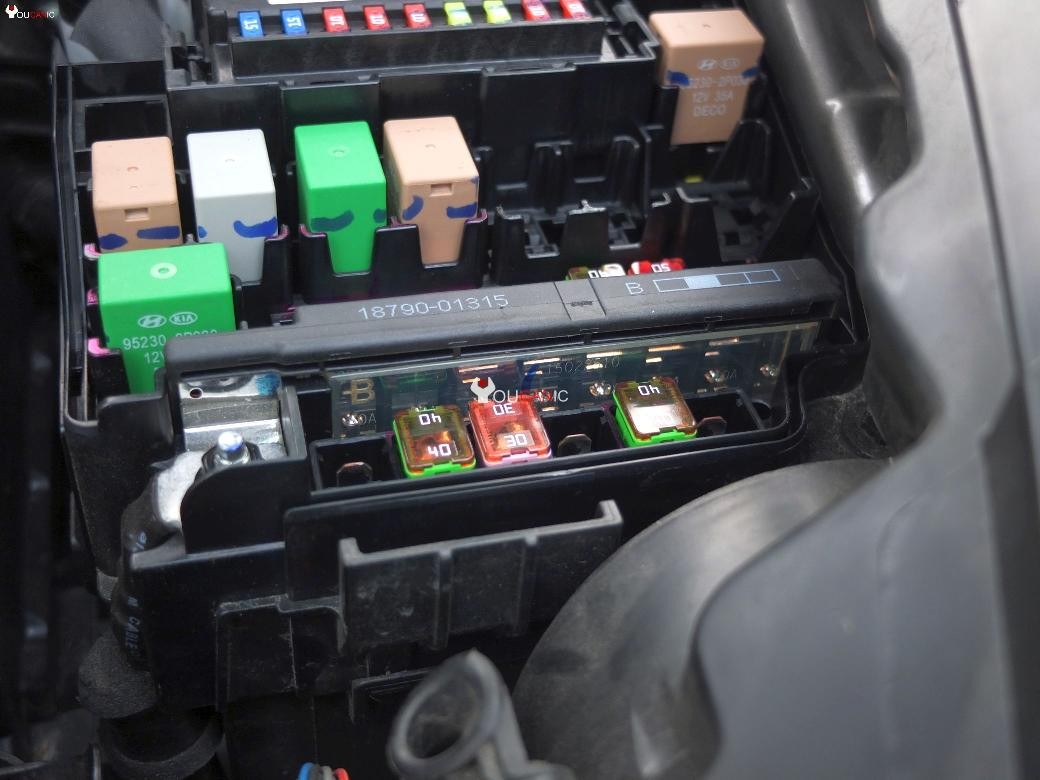 Hyundai Elantra fuse box layout, illustrating the position and orientation of fuses within the box.
Hyundai Elantra fuse box layout, illustrating the position and orientation of fuses within the box.
How to Check for a Blown Fuse
Identifying a blown fuse is a straightforward process:
- Visual Inspection: Remove the fuse from the fuse box. Hold it up to the light and look at the thin wire inside the fuse.
- Check for a Broken Wire: If the wire is broken or melted, the fuse is blown and needs replacement. Sometimes, the fuse might also have a dark or burnt appearance inside.
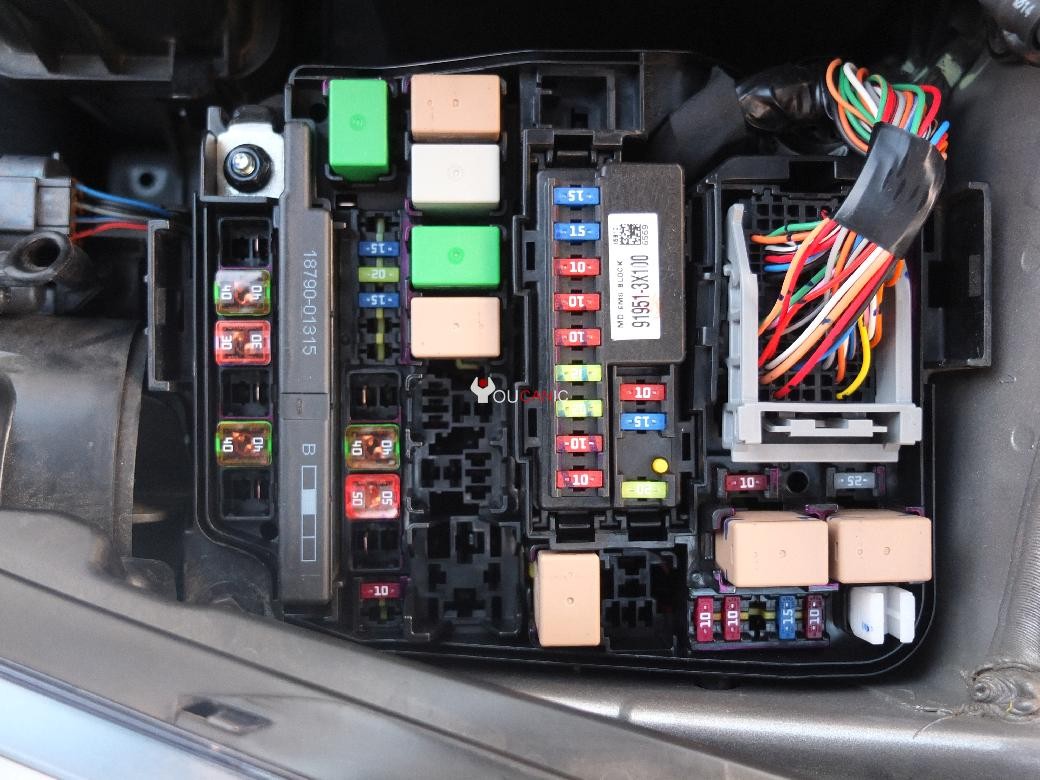 Close-up image of Hyundai Elantra fuses, highlighting different types and ratings for various electrical components.
Close-up image of Hyundai Elantra fuses, highlighting different types and ratings for various electrical components.
Replacing a Fuse in Your 2013 Hyundai Elantra
When replacing a blown fuse:
- Use the Correct Fuse Type and Rating: Refer to the fuse diagram to determine the correct fuse amperage (rating) for the circuit. Using a fuse with a higher rating can damage the electrical system. Hyundai Elantras typically use blade-type mini fuses.
- Remove the Blown Fuse: Use a fuse puller (often found in one of the fuse boxes) or needle-nose pliers to gently remove the blown fuse.
- Install a New Fuse: Push the new fuse firmly into the fuse slot.
- Test the Circuit: After replacing the fuse, test the affected component to ensure it is working correctly. If the new fuse blows immediately, there might be a more significant electrical issue requiring professional diagnosis.
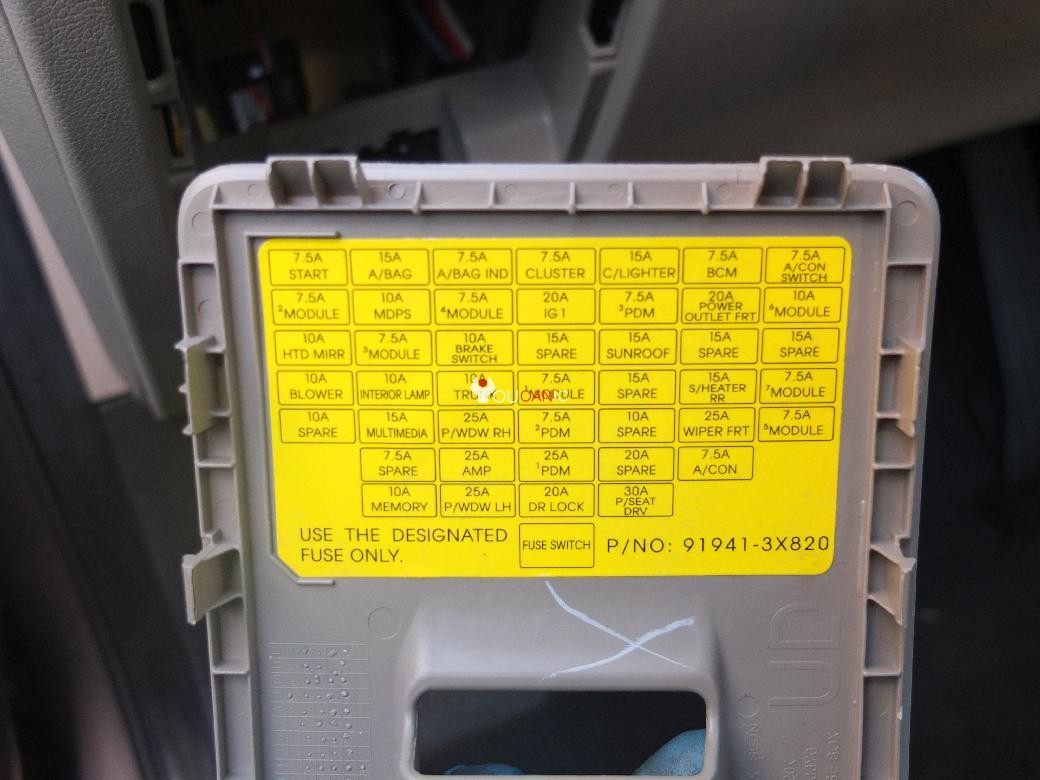 Assortment of Hyundai Elantra fuses, showcasing various colors and amperage ratings for different vehicle systems.
Assortment of Hyundai Elantra fuses, showcasing various colors and amperage ratings for different vehicle systems.
Frequently Asked Questions about Hyundai Elantra Fuses
Where are the fuse boxes located in my 2013 Hyundai Elantra?
Your 2013 Hyundai Elantra has two main fuse box locations:
- Inside the car, under the dashboard on the driver’s side.
- In the engine compartment, typically near the battery.
How can I tell if a fuse is blown?
Visually inspect the fuse. If the thin wire inside is broken or melted, or if there’s a dark mark inside the fuse, it’s likely blown.
What is the cost of replacing a fuse?
A single fuse is inexpensive, usually costing between $10 and $20 if you replace it yourself. If you go to a dealership, the cost could be around $100, often due to labor charges and diagnostics.
Conclusion
Knowing the 2013 Hyundai Elantra OBD2 fuse location, along with all fuse box locations and fuse types, empowers you to perform basic electrical system troubleshooting. Regularly checking your fuses can help you quickly resolve minor electrical issues and maintain the optimal performance of your vehicle. Remember to always use the correct replacement fuses and consult a professional if you encounter persistent blown fuses or complex electrical problems.
For further assistance with your Hyundai Elantra, explore our other troubleshooting and repair guides for expert advice and solutions.

